Feeding the University
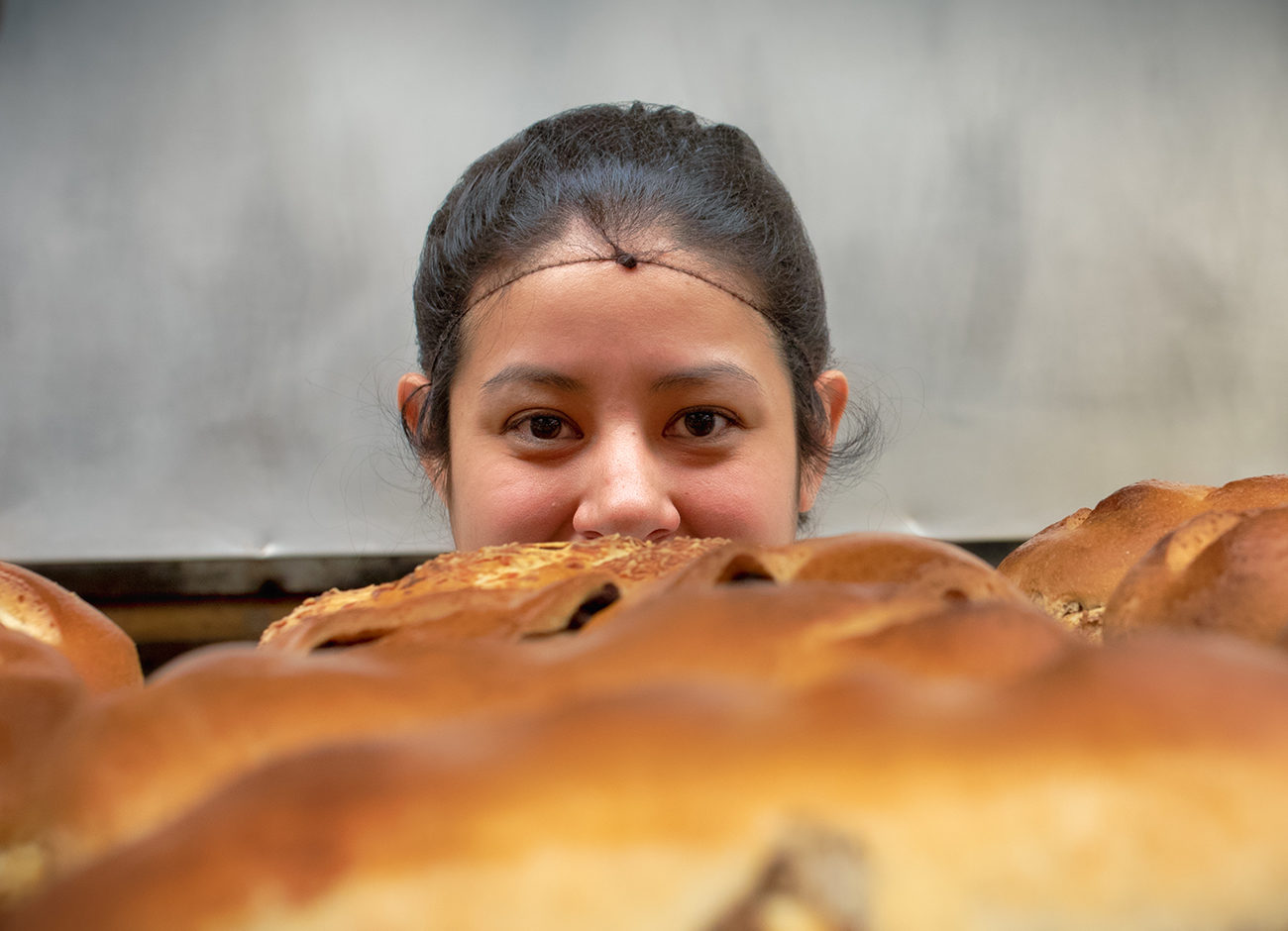
Stephanie Ordaz arrives at the Junction on the campus of Utah State University at 2 a.m. when the temperature outside is 6 degrees and an arctic wind is blasting out of Logan Canyon.
She hastily sheds her coat, dons a clean chef shirt beneath a white apron that extends to her knees, and pulls her dark hair pulled back inside a nylon honeycomb hair net.
She moves quickly, turning on ovens and moving bagels from the cooler to the humid proofing cabinets needed for nudging the sleepy yeast. She swiftly weighs and mixes dozens of loaves that will become Hazel’s bread―cutting 60 pounds of dough into individual pieces from the 600-pound bulk for baking that day.
Without fanfare, she quietly goes about her regular routine marking the start of a new day in an endless cycle of feeding the university. She is part of a legion of employees under the wide apron of USU Dining Services.
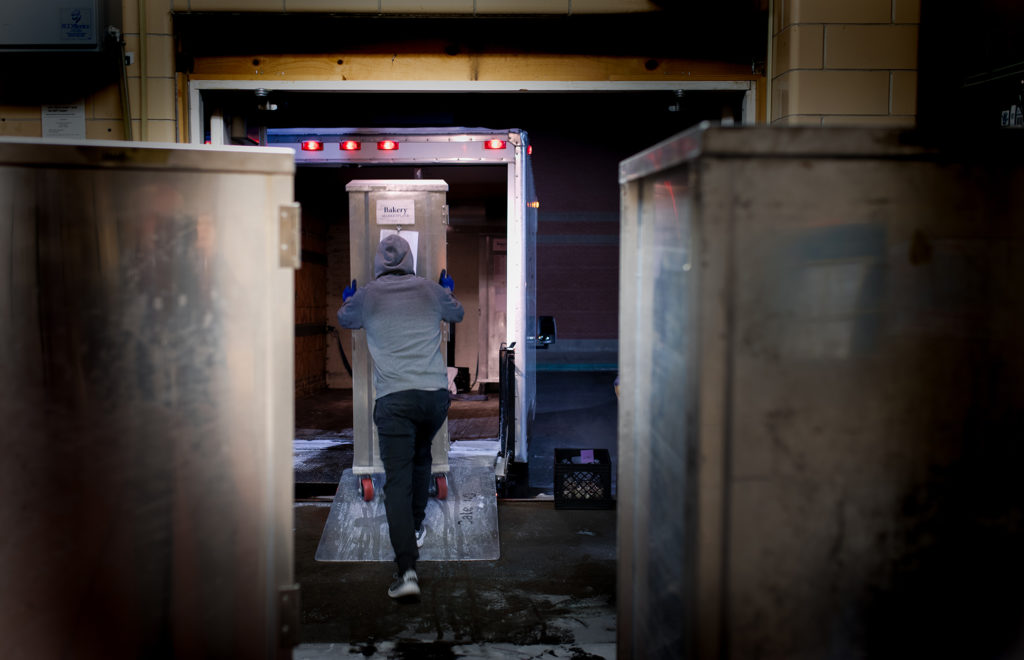
Loading the truck for 6 a.m. delivery.
Teams within Teams
“We serve 8,000 guests per day around here,” says Alan Andersen, executive director of dining services. “With 30 full-time people and 350 students, we are managing a very complicated team to make it happen.”
Teams within teams, like the baking crew, that also includes Carrie Olson, morning supervisor, and Steven Wright, head baker. Small in number but mighty in productivity. Every portion of Hazel’s bread, swirled with blueberry and raspberry for French toast, comes from this thick-walled fallout shelter relic cradled between Mountain View Towers and Richards Hall. Every slice that holds the famous Marv N’ Joe tomato and cheese sandwiches, every bagel (260,000 per year), glazed doughnut (46,000 annually), Danish, croissant, turnover, and every one of the 15,000 muffins per year. Every minute matters if they are to meet their 6 a.m. delivery deadline.
By 8:20 a.m., Jaime Castillo, a junior in agribusiness, from Ogden, is just finishing a sweet roll Olson had lathered with orange topping hours before. He is rushing off to class, but not before grabbing his customary pastry, apple, and Caffé Ibis coffee, and with no idea that people got up so early to make that possible.
Food Connections
It may seem like a thankless job, and one in which those who prepare and serve the food work in isolation, but there is satisfaction derived in being part of “a really complex thing that works pretty dang well,” says Donald Donaldson, chief executive chef. For ultimately, it is the paninis, pastries, and everything else emanating from their kitchens that links them to students like Castillo.
“I relate to the food that connects us,” he says. “If the food is presented and they like it, then that’s how I like them. And if they keep coming back, that’s how they like me.”
The Junction is Donaldson’s domain. At 6-feet 3-inches tall, he needs no traditional chef’s toque to make his presence known in the kitchen. It is mostly unspoken, though, for like everyone else this day rushing around at 5 a.m., there is no time for chatting.
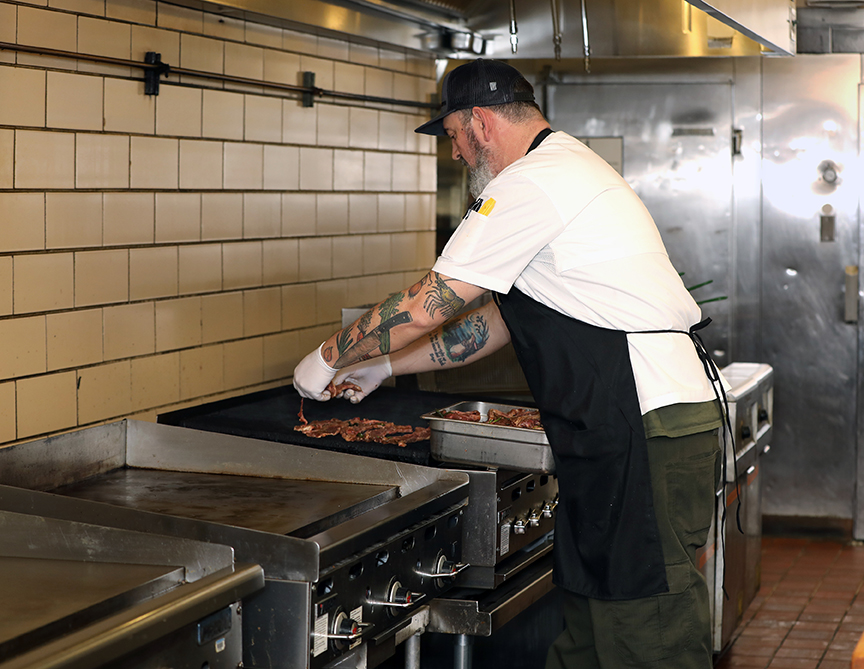
Chef Don Donaldson not only decides what is on the menu in the Junction, but also at most of the university’s 13 cafes.
His responsibilities not only entail creating the menus and meals for the 800 students each day in the Junction, but for eight of the 13 cafés on campus. The complications that he and Andersen refer to come into play here, for every café has its own menu, and personality. For a Bohemian vibe, there’s the Artist’s Block Café & Bakery, for cosmopolitan, Luke’s Café on the Quad and Shaw’s 88 Kitchen in the Huntsman Center. For somewhere smart and upscale, Noni’s Coffee Shop in the newly refurbished Nora Eccles Harrison Museum of Art. In addition, a student favorite, the Quadside Café, with its metro-corner bustle.
Even the traditional dining halls, such as the Junction and the Marketplace mix it up by offering an array of food options, such as fresh salmon and steaks at the Junction every Friday. For those who favor the familiar, the Hub offers both university originals and name-brand fast foods. (We’re looking at you, Andersen, and that Taco Time Country Breakfast Burrito that starts your day.)
Tastes vary. Students love the barbeque at the Quadside, but black bean hummus, not so much. Meatloaf sells like gangbusters at Luke’s, but not at Artist’s Block. It means rotating menu items among the cafés until they find the ones that sell best at each location. Same for the soups, all coming out of one tiny kitchen in the basement of the Junction. Last count, 20 varieties, Donaldson says.
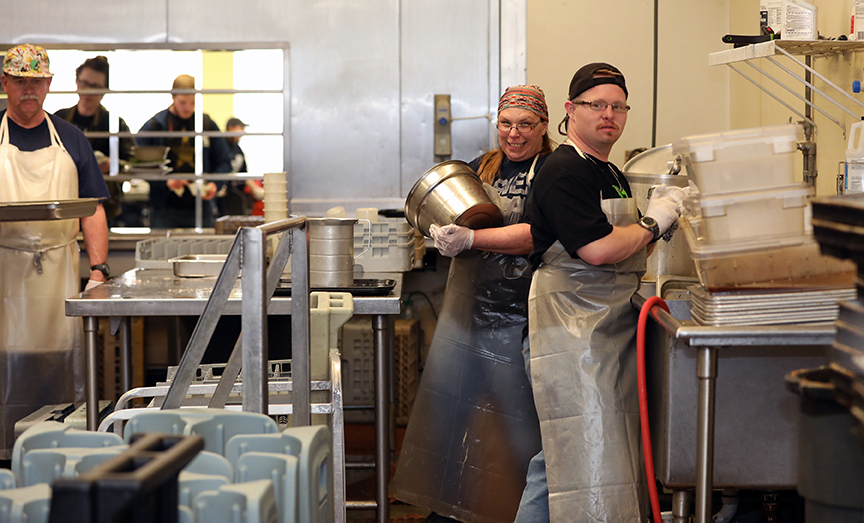
The dish washing crew keeps the kitchen in working order.
“We don’t want to waste money, time, or food, or disappoint people by trying to sell them something that they don’t want or have them buy something begrudgingly,” he says. “I didn’t start cooking food to make people feel bad. I did this because I get a lot of pleasure out of food.”
What’s on the Menu
He comes from a culinary school in New Jersey and prides himself in understanding good food and turning basic ingredients into something special. It is important enough to have a formidable cooking knife and key food elements tattooed on his left arm. (He has given his right arm to his children, which prominently includes a bunny.) On his chef’s arm, you see a shallot, leek, carrot, celery and onion, with garlic in the works.
“They’re the aromatics of all sauces, and a lot of dishes,” he says. “I’ll probably be doing some herbs also, rosemary, thyme, parsley and sage, and Simon and Garfunkel it up.”
It is not without stipulation whenever he embarks on creating a menu that a student would like, but on a student budget. “My rule: if you wouldn’t feed it to your mother, we’re not going to feed it to them―unless you hate your mother.” The good news: Donaldson loves his mom.
Jeff Woolley, executive chef in the Taggart Student Center, goes a step further. “If it is something I wouldn’t eat, then I won’t serve it.” Then he quickly backtracks when he thinks about lamb, a food he has not been able to stomach since childhood. He still serves it though, if not with a dash of valor.
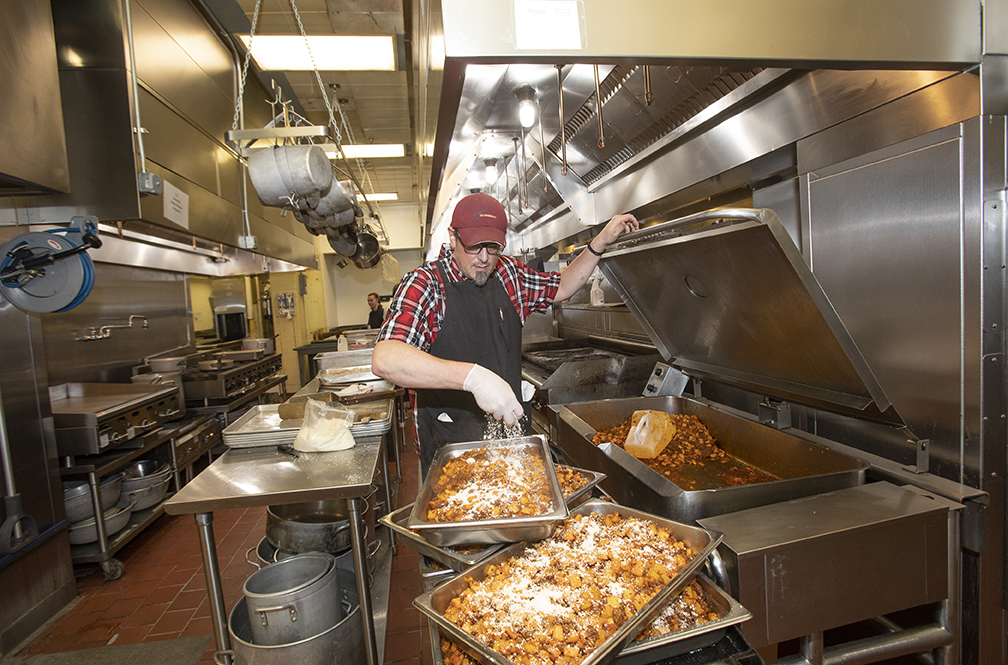
Executive Chef Jeff Woolley.
On this particular day, the menu calls for London broil with Chimichurri sauce, sautéed mushrooms and onions, sweet potato fries, garlic roasted Yukon potatoes and steamed vegetables for his 1,500 Marketplace guests. A menu he first etched out on his iPad to help him picture colors and combinations. He also arms himself with tiny plastic spoons for constantly tasting and adjusting ingredients.
Woolley earned a culinary arts degree from USU’s Nutrition and Food Sciences before the program ended in 2007. He has cooked at the university for 22 years. Today he has a trio of chefs and 14 cooks under his purview―including the Sky Room, with its own chef―and catering services that also includes a designated chef de cuisine. In addition, Amy Rasmussen, assistant director of catering and special venues, oversees three full-time staff and 55 part-time students. This past year, they catered 3,100 events that fed a whopping 214,354 people. Their single largest day: 4,887. “That was a very busy, long day,” she says.
Campus Kitchen
This same afternoon was shaping up to be equally active with the debut of the Campus Kitchen at USU in the Hub, a space donated by Dining Services. It is part of a volunteer consortium at the university focused on feeding hungry students and giving back to the community, says Nelda Ault-Dyslin, ‘05, Val R. Christensen Service Center coordinator.
They work closely with the Student Nutrition Access Center (SNAC) that takes advantage of Dining Services’ policy of never serving day-old bread and pastry items. For the past eight years, SNAC has gathered and distributed these unused food items, combined with canned foods from the Cache Community Food Pantry, to students in need. A 2017 USU study conducted in partnership with SNAC, reported that 63 percent of USU students surveyed revealed that they experienced food insecurity at some point in their college career.
The new Campus Kitchen at USU creates individual cold meals assembled from the food gathered by SNAC and other donations from local restaurants. What is a bagel today becomes a bagel chip tomorrow. Nothing goes to waste. Andersen and Jaime Bradford, associate director of retail operations, thrive on this synergy―using every scrap of food and every dollar they can scrape together. This helps to explain the radical transformation of the USU campus dining experience over the past 30 years, about the time Andersen started at USU.
He recalls when most all campus food offerings were limited to the TSC. Not too much different from how students dined in the student union a century before that, cafeteria style. Back then, choices were limited. Potatoes, chili, and pie were favorites of the Class of 1922.
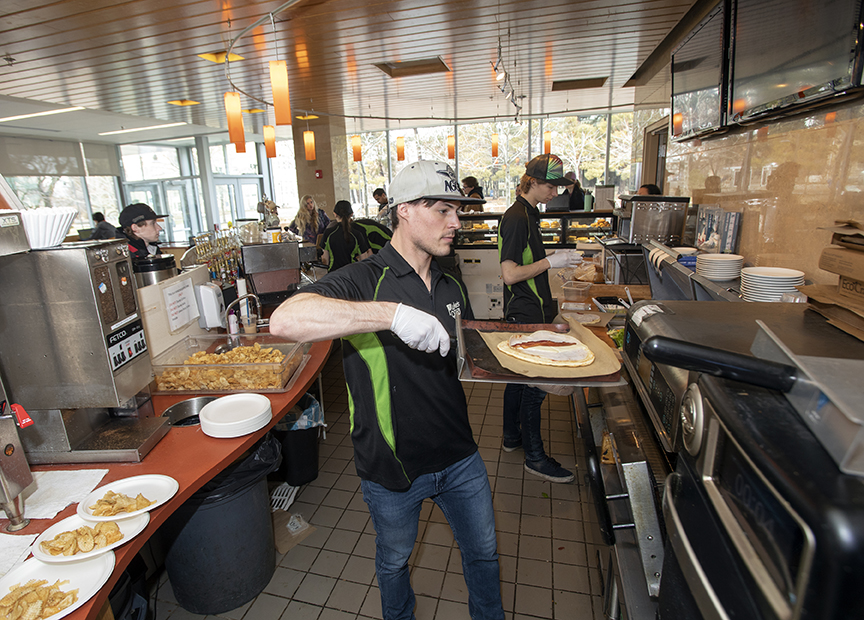
Lunch time at Luke’s Cafe.
Variety and Options
Students today mostly come from two-income families, where time-strapped parents rely more heavily on pre-prepared meals and dining out, Andersen surmises. He sees the campus offerings as merely an extension of this new way of life. The variety and options are just something they have come to expect.
It has its appeal for Kathryn Cox, a sophomore from Farmington, Utah, studying environmental engineering. She has just enough time to grab a bagel before heading to class. Her part-time job in the Science Engineering Research right across from the Quadside Café is a big plus.
Andersen and Bradford say they think about students like Cox all of the time. What it is she likes that is also affordable and convenient? They note that the abundance of eating establishments on campus sets the university apart.
“It’s unique how many cafés USU has in such a condensed area,” Andersen says. “It creates challenges to make sure they’re not all the same and finding that niche.”
Therefore, it was in a bit of desperation that they suggested a theme for the newest campus café in the Life Sciences Building focusing on teas and cheese. While it sounded crazy at first, ultimately the idea caught on. It had just the right Marv N’ Joe combination of good, basic food elements, and within a student’s budget.
It used to be that campus buildings consisted mainly of long corridors and classrooms, but today students want places and spaces for conversation, places where they can go to not only share notes, but also meals. It is why cafés are becoming an integral part of a university building’s design. Look no further than Beth’s Café at the south entrance of the Sorenson Center for Clinical Excellence. It is a bright and cheery space that greets every student, client, faculty, and staff who enters its doors, Andersen says.
“We’ve been focused on this for quite a few years, of creating a welcoming and excellent college experience,” he says. “We see our role in the university bigger than just providing food.”
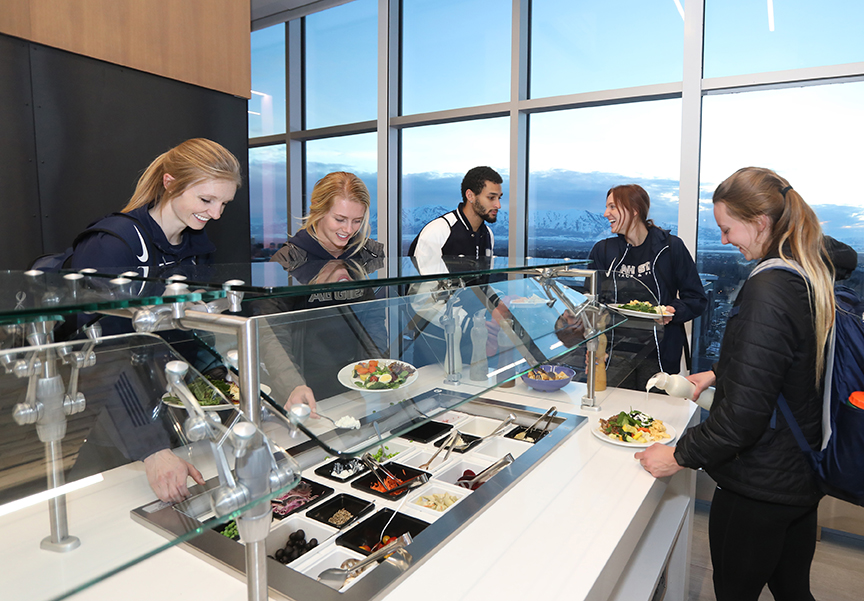
The Training Table program provides food to student athletes three evenings each week.
The Training Table
It is 5 p.m. and he is about to head out the door to check on how things are going on the third floor of the West Stadium where catering serves up a small feast to 325 athletes three times per week as part of the Training Table program.
It has been 10 hours since most of the cafés and dining areas began serving breakfast. The Marketplace will stay open for another two hours for students who are getting out of night classes.
By 9:30 p.m., the dish room staff and cleaning crew are finishing up. Typically, though, it is catering that clocks out last—sometimes as late as 3 a.m. on football game nights.
Gratefully, on this day, it is only 11 p.m. In just two hours, Ordaz will be waking up for the start of a new day at the Junction. She will have ovens to warm, and a campus to feed, certain as the day is long for Dining Services, sure as the winds that howl from Logan Canyon.
By John DeVilbiss
Click here for Blueberry-Lemon pie recipe.






